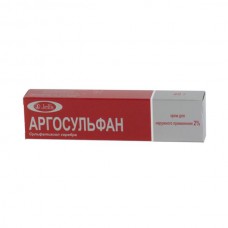Expiration date: 02/2026
leftover and release form:
Cream 1 g
sulfathiazole silver salt 20 mg
base to 1 g
base components: liquid paraffin cetostearyl alcohol petrolatum sodium lauryl glycerin propilgidroksibenzoat metilgidroksibenzoat potassium hydrogen phosphate sodium dihydrogen phosphate water for injections
in aluminum tubes of 15 and 40 g in a box of 1 tube or in polypropylene boxes of 400 g.
Characteristic:
White or white with a shade of pink to light gray, homogeneous soft mass.
Pharmacological action:
Argosulfan cream — antibacterial drug for topical use, promotes healing of wounds (burn, trophic, purulent, etc.), provides effective protection of wounds from infection, relieves pain and burning in the wound, reduces the time of treatment and preparation of the wound for skin transplantation, in many cases leads to an improvement, eliminating the need for transplantation.
Part of the cream is a sulfonamide — sulfatiazol has a broad spectrum bacteriostatic with antibacterial action against gram-positive and gram-negative bacteria. The mechanism of antimicrobial action of sulfathiazole — inhibition of growth and reproduction of microbes associated with competitive antagonism with PABA and inhibition of dihydropteridine, which leads to impaired synthesis of dihydrofolic acid and, ultimately, its active metabolite tetrahydrofolic acid required for the synthesis of purines and pyrimidines microbial cells. Present in the preparation of silver ions enhance several tens of times the antibacterial effect of sulfonamide — they inhibit the growth and division of bacteria by binding to the DNA of the microbial cell. In addition, silver ions weaken the sensitizing properties of sulfanilamide.
Thanks to the hydrophilic base of the cream, which has an optimal pH and contains a large amount of water, provides analgesic effect and hydration of the wound, contributing to good tolerability, relief and acceleration of wound healing.
Pharmacokinetics:
The silver salt of sulfatiazole contained in the preparation has a small solubility, as a result of which, after topical application, the concentration of the drug in the wound is maintained at the same level for a long time. Due to the minimal resorption of the drug, it does not have a toxic effect. Only a small number of silver salts sulfathiazole is in the bloodstream, and then subjected to liver the acetylation.
In urine is in the form of inactive metabolites and partly in unchanged the form of. Absorption sulfathiazole increases after applying medications to large wound surfaces.
Indications:
Burns of various degrees, of any nature (thermal, solar, chemical, electric current, radiation, etc.), frostbite.
Bedsores, trophic ulcers of the lower leg of various Genesis (including chronic venous insufficiency, obliterating endarteritis, blood supply disorders in diabetes, erysipelas, etc.).
Purulent wounds, minor domestic injuries (cuts, abrasions).
Infected dermatitis, contact dermatitis simple, complicated impetigo, eczema, microbial, streptostafilodermii.
Contraindications:
Hypersensitivity (including to other sulfonamides), congenital glucose deficiency?6-phosphate dehydrogenases, early childhood (newborns and infants up to 2 months, premature infants) due to the risk of developing nuclear jaundice.
It is not recommended to use during pregnancy. During lactation, the drug can be prescribed only if the surface of the burn does not exceed 20% of the body surface, and the therapeutic benefit for the mother is greater than the possible risk for the child.
Side effect:
Skin allergic reactions. Sometimes possible irritation, manifested by burning in the place of application of the cream. With long-term use may develop changes in the blood, characteristic of systemic sulfonamides (eg leukopenia), desquamative dermatitis.
Drug interaction:
It is not recommended to use together with other local medicines. Folic acid and its structural analogues (e.g. procaine) can reduce the antimicrobial effect of sulfathiazole.
Dosage and administration:
Externally, as an open method, and in the form of occlusive dressings.
After cleansing and surgical treatment on the wound in compliance with the conditions of sterility, the drug is applied 2-3 mm thick 2-3 times a day. During treatment, the entire wound should be covered with cream. If part of the wound opens, you need to apply additional cream. Occlusion dressing is possible but not mandatory.
The cream is applied until the wound heals completely or until the skin transplant. If the drug is used on infected wounds, exudate may appear. Before using the cream, wash the wound with antiseptic.
The maximum daily dose is 25 g. the Maximum duration of treatment is 60 days.
Overdose:
Cases of overdose are not registered.
Special instruction:
In long-term care and extensive wound surfaces should monitor the level of sulfathiazole in plasma, especially in patients with diseases of the liver and kidneys.
Be careful when used in shock patients with extensive burns due to the inability to collect a full allergic history.
Argosulfan cream, applied locally, does not cause darkening of the skin and underwear.
Does not limit the psychophysical ability, ability to control vehicles and maintenance of machinery in motion.

